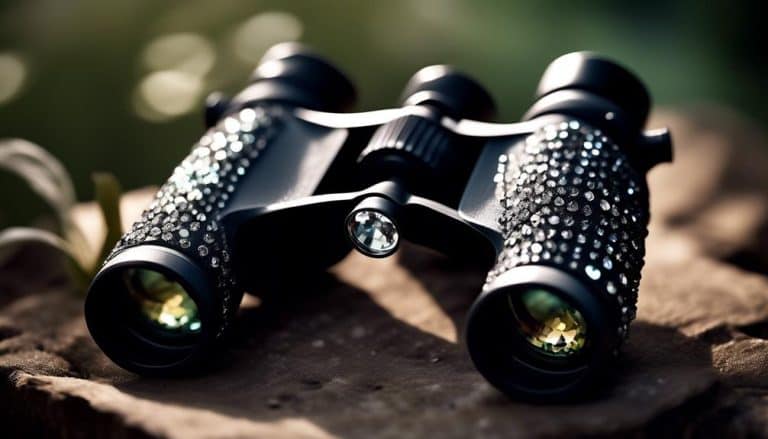As the saying goes, 'birds of a feather flock together,' and indeed, Minnesota is home to a remarkable array of large avian species. From the iconic Bald Eagles that soar through the sky, a symbol of freedom and strength, to the elegant Sandhill Cranes that gracefully navigate their way across the state, these majestic creatures never fail to captivate our attention.
But it doesn't end there. The Great Blue Herons stand tall and regal, the American White Pelicans flaunt their vibrant plumage, and the watchful eyes of the Red-tailed Hawks keep a vigilant watch over their territories.
But why are these birds so fascinating? What unique characteristics and behaviors do they possess? Join me on a journey as we unravel the secrets of these magnificent creatures and discover the wonders that await us in the skies of Minnesota.
Bald Eagles: The Symbol of Freedom
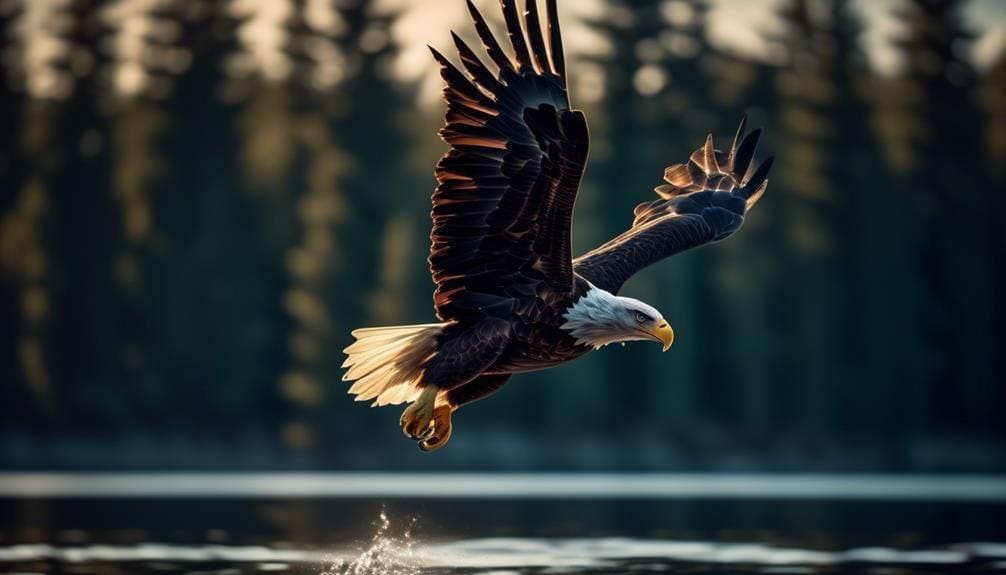
Bald Eagles, often revered as the majestic symbol of freedom, can frequently be spotted soaring high above the Minnesota skies. These magnificent birds hold great symbolism in American culture, representing both strength and independence. As a wildlife enthusiast, I've had the privilege of observing these regal creatures in their natural habitat and have been struck by their awe-inspiring beauty.
The habitat preservation efforts in Minnesota have played a crucial role in the resurgence of the Bald Eagle population. These birds require large, undisturbed areas near bodies of water, where they build their nests and hunt for fish. Thanks to conservation initiatives, such as the protection of nesting sites and the reduction of harmful pesticides, the Bald Eagle population has made a remarkable recovery.
One of the most remarkable aspects of Bald Eagles is their ability to adapt to various habitats. While they prefer areas with abundant fish populations, they can also be found in coastal regions and near rivers. Their impressive wingspan and powerful flight allow them to cover vast distances in search of food and suitable nesting sites.
Graceful Sandhill Cranes
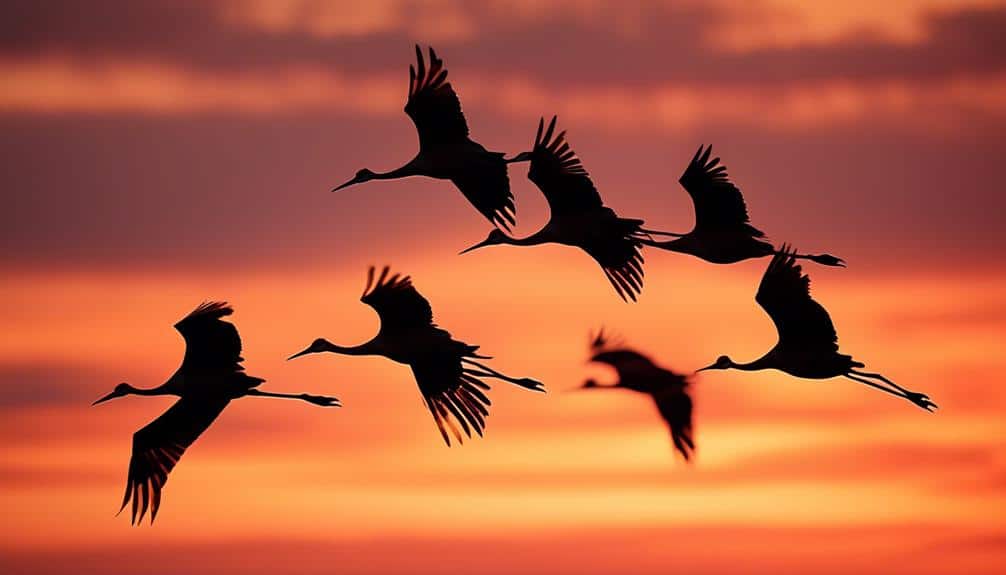
As I continued my exploration of large birds in Minnesota, my attention shifted from the awe-inspiring Bald Eagles to the graceful Sandhill Cranes, captivating me with their elegant presence and intriguing behaviors. These majestic birds, known for their long legs and distinctive red crown, engage in courtship dances that are a sight to behold.
Here are three fascinating aspects of the graceful Sandhill Cranes:
- Courtship Dances: During the breeding season, male Sandhill Cranes perform elaborate dances to attract females. With outstretched wings and graceful leaps, they engage in a series of synchronized movements, accompanied by loud calls that echo through the wetlands. These courtship displays not only demonstrate the males' physical prowess but also serve as a bonding ritual between mates.
- Migratory Patterns: Sandhill Cranes are highly migratory birds, undertaking long-distance journeys between their breeding grounds in Minnesota and their wintering grounds in the southern United States. These birds form large flocks and follow specific migration routes, utilizing thermals and air currents to conserve energy during their arduous journeys. Their annual migration is a testament to their remarkable navigational abilities.
- Family Structure: Sandhill Cranes exhibit strong familial bonds. They form lifelong pair bonds and often return to the same nesting sites year after year. Both parents take turns incubating the eggs and caring for the young, which are known as colts. These family units stay together even after the colts fledge, fostering a sense of community among the Sandhill Crane population.
The graceful Sandhill Cranes are truly captivating creatures, with their courtship dances and impressive migratory patterns. Witnessing their elegant movements and observing their tight-knit family structure is a privilege for any nature enthusiast.
Majestic Great Blue Herons
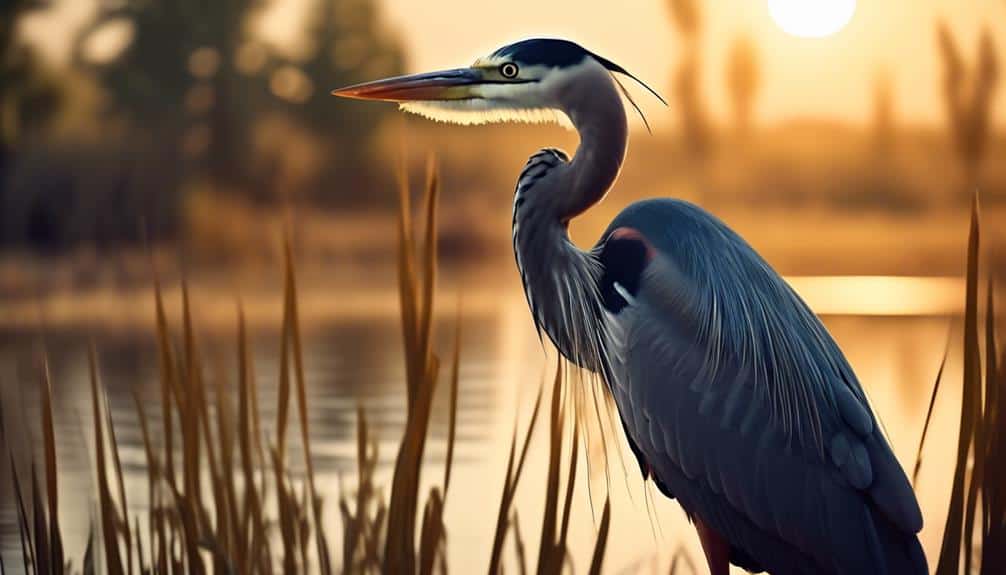
The magnificent Great Blue Herons, with their imposing stature and striking blue-gray plumage, command attention as they gracefully navigate the wetlands of Minnesota. These majestic birds are known for their distinct behaviors and habitats.
Great Blue Herons are solitary birds, often seen standing motionless near bodies of water, patiently waiting for their prey. With their long legs and sharp beaks, they're skilled hunters, catching fish, frogs, and small mammals with precision and speed. Their behavior is fascinating to observe, as they use their sharp eyesight to spot their prey from a distance, and then swiftly strike with their powerful beaks.
When it comes to habitats, Great Blue Herons prefer wetlands such as marshes, swamps, and shallow lakes. These areas provide them with an abundant food supply and suitable nesting sites. They build large nests on tall trees or in colonies, called heronries, where they raise their young. These nests are often located near water bodies, allowing easy access to food for both the adults and their chicks.
Colorful American White Pelicans
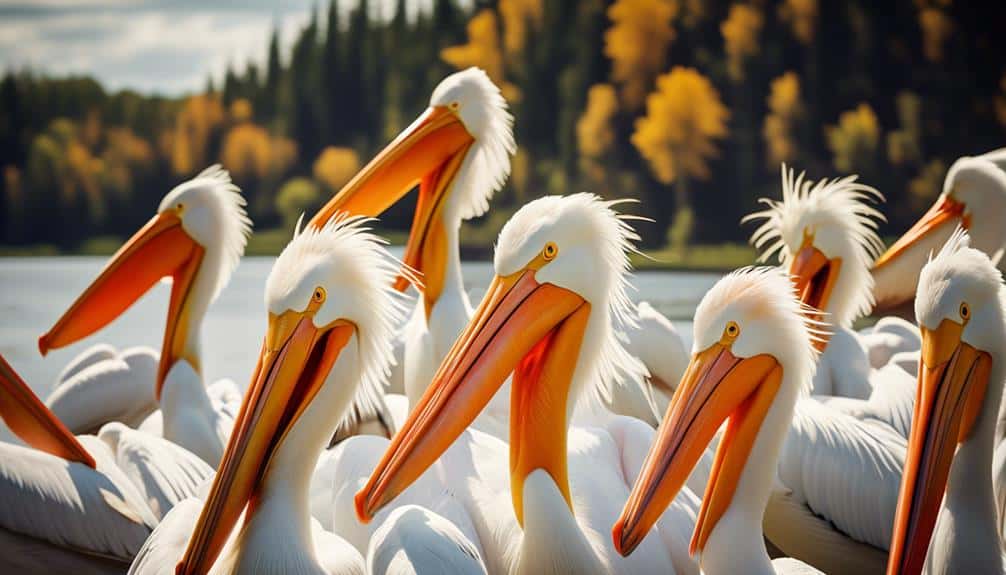
Colorfully adorned with bright white plumage and a distinctive orange bill, American White Pelicans are a captivating sight as they glide effortlessly across the Minnesota skies. These magnificent birds exhibit fascinating migration patterns, traveling long distances to reach their breeding grounds.
Here are three remarkable aspects of their behavior:
- Cooperative feeding: American White Pelicans are known for their unique feeding habits. They employ a method called 'cooperative fishing,' where a group of pelicans forms a semicircle in shallow water, herding fish towards the center. This synchronized effort allows them to catch a significant amount of prey in a short period.
- Impressive wingspan: When in flight, American White Pelicans showcase their impressive wingspan, which can reach up to nine feet. Their broad wings enable them to soar gracefully through the air, effortlessly navigating the Minnesota landscape.
- Seasonal movements: These pelicans exhibit a distinct migration pattern, spending their winters in warmer regions and returning to Minnesota during the breeding season. Their arrival in the spring signifies the onset of warmer weather and the abundance of prey in the state's lakes and rivers.
As I observe these colorful American White Pelicans, I'm awe-struck by their majestic appearance and intricate behaviors. Their migration patterns and feeding habits are a testament to their adaptability and survival strategies in the ever-changing Minnesota ecosystem.
Watchful Red-tailed Hawks
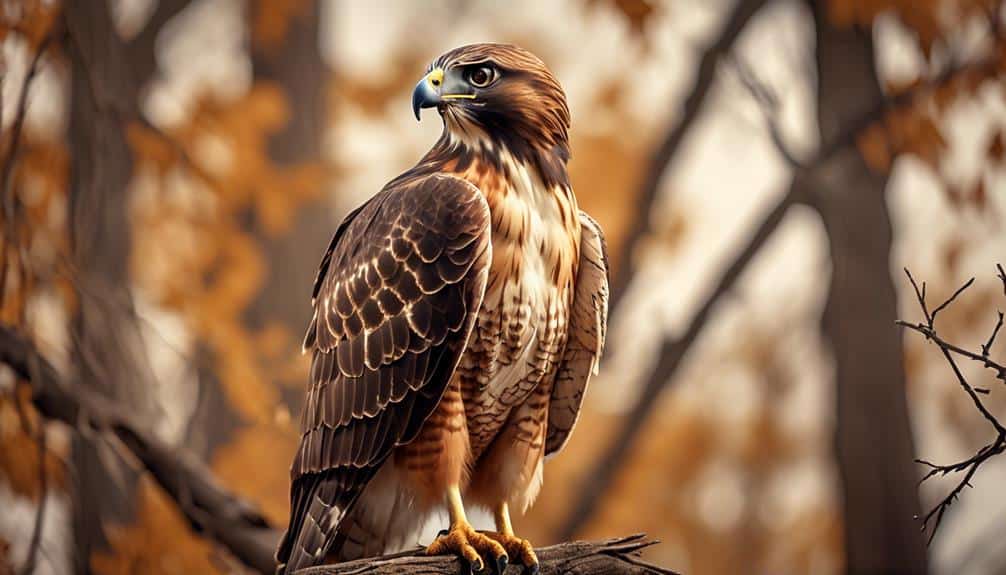
Perched high atop the treetops, the watchful Red-tailed Hawks exhibit a keen sense of vigilance as they scan the Minnesota landscape for potential prey. Their behavior is characterized by a patient and strategic approach, as they patiently wait for the perfect moment to swoop down and capture their unsuspecting target. These magnificent birds of prey are known for their distinct red tails, which become more prominent as they mature.
Red-tailed Hawks are found in a variety of habitats throughout Minnesota, including forests, grasslands, and wetlands. They prefer areas with open spaces and perches that provide them with a clear line of sight to observe their surroundings. These habitats offer an abundance of food sources such as small mammals, birds, and reptiles, which serve as their primary prey.
When hunting, Red-tailed Hawks employ a range of techniques to increase their chances of success. They soar high in the sky, utilizing their excellent eyesight to spot potential prey from great distances. Once a target is identified, they employ their powerful wings to dive swiftly towards their prey, using their sharp talons to secure a firm grip. Their strong beaks are then used to tear apart their catch into manageable pieces.
Frequently Asked Questions
How Many Bald Eagles Are Typically Found in Minnesota?
Typically, there are a significant number of bald eagles in Minnesota. They are a prominent part of the state's large bird population. The sandhill crane lifespan is also an interesting topic to explore.
What Is the Lifespan of a Sandhill Crane?
Sandhill cranes have a lifespan of up to 20 years. They are known for their elaborate courtship dances and long-term pair bonding. Conservation efforts have been made to protect their habitats and breeding grounds.
Do Great Blue Herons Migrate to Warmer Regions During the Winter?
Yes, great blue herons do migrate to warmer regions during the winter. They exhibit a fascinating behavior of flying long distances to find more favorable climates, which is a common migration pattern among many bird species.
How Do American White Pelicans Catch Their Prey?
When it comes to pelican feeding behavior, their hunting techniques are fascinating to observe. With their impressive wingspan and keen eyesight, American white pelicans effortlessly scoop up fish from the water using their expandable pouches. It's a sight to behold.
Are Red-Tailed Hawks Endangered in Minnesota?
Red-tailed hawks are not endangered in Minnesota. However, they are a species of concern due to habitat loss and human activities. Conservation efforts are focused on protecting their habitats and raising awareness about their importance in the ecosystem.
Conclusion
As I watched these magnificent creatures soar through the Minnesota skies, I couldn't help but feel a sense of awe and wonder. Each bird, with its unique characteristics and behaviors, represented something more than just its physical presence. They symbolized freedom, grace, majesty, and vigilance.
Like the birds, we too have the power to soar to great heights and overcome any obstacle that comes our way. Let these birds be a reminder to embrace our inner strength and strive for greatness in all that we do.



